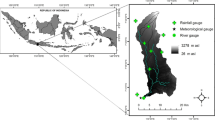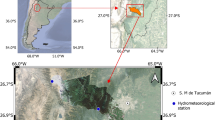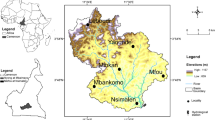Abstract
This study evaluated the impact on watershed hydrology by predicting future forest community change under a climate change scenario. The Soil and Water Assessment Tool (SWAT) was selected and applied to Chungju dam watershed (6,642 km2) of South Korea. The SWAT was calibrated and validated for 6 years (1998–2003) using the daily streamflow data from three locations. For the future evaluation of forest community and hydrology, the MIROC3.2 HiRes monthly climate data were adopted. The future data were corrected using 30 years (1977–2006, baseline period) of measured weather data, and they were daily downscaled by the Long Ashton Research Station-Weather Generator statistical method. To predict the future forest vegetation cover, the baseline forest community was modeled by a multinomial LOGIT model using variables of baseline precipitation, temperature, elevation, degree of base saturation, and soil organic matter, and the future forest community was predicted using the future precipitation and temperature scenario. The future temperature increase of 4.8 °C by 2080s (2070–2099) led to prediction of 30.8 % decrease of mixed forest and 75.8 % increase of coniferous forest compared to the baseline forest community. For the baseline evapotranspiration (ET) of 491.5 mm/year, the 2080s ET under the forest community change was 591.1 mm/year, whereas it was 551.8 mm/year with the remaining forest community stationary. The different ET results considering the future forest community clearly affected the groundwater recharge and streamflow in sequence.







Similar content being viewed by others
References
Alcamo J, Doll P, Kaspar F, Siebert S (1997) Global change and global scenarios of water use and availability: an application of WaterGAP 1.0. Report A9701. Center for Environmental Systems Research, University of Kassel, Germany
Allen RG (1986) A Penman for all seasons. J Irrigat Drain Eng 112(4):348–368
Allen RG, Jensen ME, Wright JL, Burman RD (1989) Operational estimates of evapotranspiration. Agron J 81:650–662
Arnold JG, Srinivasan R, Muttah RS, Williams JR (1998) Large area hydrologic modeling and assessment part I: model development. J Am Water Resour Assoc 34(1):73–89
Augustin NH, Cummins RP, French DD (2001) Exploring spatial vegetation dynamics using logistic regression and a multinomial logit model. J Appl Ecol 38:991–1006
Austin MP (2002) Spatial prediction of species distribution: an interface between ecological theory and statistical modeling. Ecol Model 157(2/3):101–118
Belotelov NV, Bogatyrev BG, Kirilenko AP, Venevsky SV (1996) Modeling of time-dependent biomes shifts under global climate changes. Ecol Mod 87:29–40
Bonan GB (2008) Forests and climate change: forcings, feedbacks, and the climate benefits of forests. Sci Agric 320(5882):1444–1449
Boonpragob K, Santisirisomboon J (1996) Modeling potential changes of forest area in Thailand under climate change. Water Air Soil Poll 92:107–117
Dixon RK, Krankina ON, Kobak KI (1996) Global climate change adaptation: examples from Russian boreal forests. Adapt Clim Change 5:359–373
Droogers P, Aerts J (2005) Adaptation strategies to climate change and climate variability: a comparative study between seven contrasting river basins. Phys Chem Earth 30(6–7):339–346
Eckhardt K, Fohrer N, Fred HG (2005) Automatic model calibration. Hydrol Proc 19(3):651–658
Emanuel WR, Shugart HH, Stevenson MP (1985) Climatic change and broad-scale distribution of terrestrial ecosystem complexes. Clim Change 7:29–43
Engler R, Guisan A, Rechsteiner L (2004) An improved approach for predicting the distribution of rare and endangered species from occurrence and pseudo-absence data. J Appl Ecol 41:263–274
Ertsen ACD, Alkemade JRM, Wassen MJ (1998) Calibrating Ellenberg indicator values for moisture, acidity, nutrient availability and salinity in the Netherlands. Plant Ecol 135:113–124
Ficklin DL, Luo Y, Luedeling E, Zhang M (2009) Climate change sensitivity assessment of a highly agricultural watershed using SWAT. J Hydrol 347(1–2):16–29
Ficklin DL, Luo Y, Stewart IT, Maurer EP (2012) Development and application of a hydroclimatological stream temperature model within SWAT. Water Resour Res 48:W01511
Franklin J (1995) Predictive vegetation mapping: geographic modeling of biospatial patterns in relation to environmental gradients. Prog Phys Geogr 19:474–499
Goulden ML, Daube BC, Fan SM, Sutton DJ, Bazzaz A, Munger JW, Wofsy SC (1997) Physiological responses of a black spruce forest to weather. J Geophys Res 102:28987–28996
Guisan A, Zimmerman NE (2000) Predictive habitat distribution models in ecology. Ecol Model 135(2–3):147–186
Hastie T, Tibshirani R (1990) Generalized additive models. Chapman and Hall, London
Holdridge LR (1947) Determination of world plant formations from simple climatic data. Science 105:367–368
Hosmer DW, Lemeshow S (2000) Applied logistic regression. John Wiley and Sons Inc., New York
Hotchkiss RH, Jorgensen SF, Stone MC, Fontaine TA (2000) Regulated river modeling for climate change impact assessment: the Missouri River. J Am Water Resour Assoc 36(2):375–386
IPCC (2007) Climate change 2007: the physical science basis. Contribution of working group I to the fourth assessment report of the intergovernmental panel on climate change. Cambridge University Press, Cambridge, New York
IPCC-TGCIA (1999) Guidelines on the use of scenario data for climate impact and adaptation assessment: version 1. Intergovernmental Panel on Climate Change, Task Group on Scenarios for Climate Impact Assessment (IPCC-TGCIA)
Iverson LR, Prasad AM (1998) Predicting abundance of 80 tree species following climate change in the eastern United States. Ecolog Monogr 68:465–485
Jenny H (1941) Factors of soil formation. McGraw-Hill, New York
Jenny H (1980) The soil resource, origin and behavior. Springer-Verlag, New York
Jha M, Arnold JG, Gassman PW, Giorgi F, Gu R (2006) Climate change sensitivity assessment on upper Mississippi River basin streamflows using SWAT. J Am Water Resour Assoc 42(4):997–1015
Jin X, Sridhar V (2012) Impacts of climate change on hydrology and water resources in the Boise and Spokane River basins. J Am Water Resour Assoc 48(2):197–220
Kim JU (2005) A study on the vulnerability assessment of forest vegetation using regional climate model. Seoul National University, Seoul, pp 76–77
Kirilenko AP, Belotelov NV, Bogatyrev BG (2000) Global model of vegetation migration: incorporation of climatic variability. Ecol Model 132(1–2):125–133
Kwon YA, Kwon WT, Boo KO, Choi YE (2007) Future projections on subtropical regions over South Korea using SRES A1B data. J Korean Geogr Soc 42(3):355–367
Lazar B, Williams M (2008) Climate change in western ski areas: potential changes in the timing of wet avalanches and snow quality for the Aspen ski area in the years 2030 and 2100. Cold Reg Sci Technol 51(2–3):219–228
Lee JY, Lee KK (2000) Use of hydrologic time series data for identification of recharge mechanism in a fractured bedrock aquifer system. J Hydrol 229:190–201
Limaye AS, Boyington TM, Cruise JF, Bulusu A, Brown E (2001) Macroscale hydrologic modeling for regional climate assessment studies in the southeastern United States. J Am Water Resour Assoc 37(3):709–722
Mata LJ (1996) A study of climate change impacts on the forests of Venezuela. Adapt Clim Change 5:347–358
McCullagh P, Nelder JA (1999) Generalized linear models, 2nd edn. Chapman and Hall, Boca Raton
Min HJ, Jhun JG (2010) The change in the East Asian summer monsoon simulated by the MIROC3.2 high-resolution coupled model under global warming scenarios. Asia-Pacific. J Atmos Sci 46(1):73–88
Monteith JL (1965) Evaporation and environment. In: 19th symposia of the society for experimental biology, vol 19. University Press, Cambridge, pp 205–234
Moriasi DN, Arnold JG, Van Liew MW, Bingner RL, Harmel RD, Veith TL (2007) Model evaluation guidelines for systematic quantification of accuracy in watershed simulations. Trans ASABE 50(3):885–900
Myneni RB, Keeling CD, Tucker CJ, Asrar G, Nemani RR (1997) Increased plant growth in the northern high latitudes from 1981 to 1991. Nature 386:698–702
Nash JE, Sutcliffe JV (1970) River flow forecasting through conceptual models: Part 1: a discussion of principles. J Hydrol 10(3):282–290
Neitsch SL, Arnold JG, Kiniry JR, Srinivasan R, Williams JR (2002) Soil and water assessment tool: user’s manual, version 2000. TWRI Report TR-192. Texas Water Resources Institute, College Station
Park JY, Park MJ, Joh HK, Shin HJ, Kwon HJ, Srinivasan R, Kim SJ (2011a) Assessment of MIROC3.2 hires climate and CLUE-s land use change impacts on watershed hydrology using SWAT. Trans ASABE 54(5):1713–1724
Park JY, Park MJ, Ahn SR, Park GA, Yi JE, Kim GS, Srinivasan R, Kim SJ (2011b) Assessment of future climate change impacts on water quantity and quality for a mountainous dam watershed using SWAT. Trans ASABE 54(5):1725–1737
Park MJ, Shin HJ, Park JY, Park GA, Kim SJ (2012) Comparison of watershed streamflow using projected MIROC3.2 HiRes GCM data and observed weather data for 2000–2009 under SWAT simulation. Trans ASABE 55(3):1003–1010
Park JY, Park GA, Kim SJ (2013) Assessment of future climate change impact on water quality of Chungju Lake, South Korea, using WASP coupled with SWAT. J Am Water Resour Assoc 49(6):1225–1238
Parmesan C, Yohe G (2003) A globally coherent fingerprint of climate change impacts across natural systems. Nature 421:37–42
Peters J, Baets BD, Verhoest NEC, Samson R, Degroeve S, Beckerd PD, Huybrechtsd W (2007) Random forests as a tool for ecohydrological distribution modeling. Ecol Model 207(2–4):304–318
Post WM, Emanuel WR, Zinke PJ, Stangenberger AG (1982) Soil carbon pools and world life zones. Nature 298:156–159
Racsko P, Szeidl L, Semenov MA (1991) A serial approach to local stochastic weather models. Ecol Model 57:27–41
Ravindranath NH, Murthy IK, Swarnim S (2011) Options for forest management for coping with climate change in South Asia. In: Climate Change and Food Security in South Asia. Springer, Dordrecht, pp 343–358
Rodriguez-Iturbe I (2000) Ecohydrology: a hydrologic perspective of climate–soil–vegetation dynamics. Water Resour Res 36:3–9
Rushton SP, Ormerod SJ, Kerby G (2004) New paradigms for modeling species distributions. J Appl Ecol 41:193–200
Segurado P, Araujo MB (2004) An evaluation of methods for modeling species distributions. J Biogeogr 31:1555–1568
Sellers PJ (1997) BOREAS in 1997: experiment overview, scientific results, and future directions. J Geophys Res 102:28731–28770
Semenov MA, Barrow EM (2002) LARS-WG: a stochastic weather generator for use in climate impact studies: user manual. Rothamsted Research, Harpenden. Available at: www.rothamsted.ac.uk/mas-models/download/LARS-WG-Manual.pdf
Semenov MA, Brooks RJ, Barrow EM, Richardson CW (1998) Comparison of WGEN and LARS-WG stochastic weather generators for diverse climates. Clim Res 10:95–107
Somaratne S, Dhanapala AH (1996) Potential impact of global climate change on forest distribution in Sri Lanka. Water Air Soil Poll 92:129–135
Stone MC, Hotchkiss RH, Hubbard CM, Fontaine TA, Mearns LO, Arnold JG (2001) Impacts of climate change on Missouri River basin water yield. J Am Water Resour Assoc 37(5):1119–1130
Takle ES, Jha M, Anderson CJ (2005) Hydrological cycle in the upper Mississippi River basin: 20th century simulations by multiple GCMs. Geophys Res Lett 32(18):L18407.1–L18407.5
Thomas CD, Cameron A, Green RE, Bakkenes M, Beaumont LJ, Collingham YC, Erasmus BFN, de Siqueira MF, Grainger A, Hannah L, Hughes L, Huntley B, van Jaarsveld AS, Midgley GF, Miles L, Ortega-Huerta MA, Peterson AT, Phillips OL, Williams SE (2004) Extinction risk from climate change. Nature 427:145–148
Venterink H, Wassen MJ (1997) A comparison of six models predicting vegetation response to hydrological habitat change. Ecol Model 101:347–361
Walther GR, Post E, Convey P, Menzel A, Parmesan C, Beebee TJC, Fromentin JM, Hoegh-Guldberg O, Bairlein F (2002) Ecological responses to recent climate change. Nature 416:389–395
Woodward FI (1987) Climate and plant distribution. Cambridge University Press, New York
Yee TW, Mitchell ND (1991) Generalized additive-models in plant ecology. J Veg Sci 2:587–602
Acknowledgments
This study was supported by the Center for Aquatic Ecosystem Restoration (CAER) of the Ecostar project from the Ministry of Environment (MOE), Republic of Korea (MOE; EW-55-12-10), and the National Research Foundation of Korea (NRF) grant funded by the Korea government (MEST) (No. 2013-065006).
Author information
Authors and Affiliations
Corresponding author
Rights and permissions
About this article
Cite this article
Shin, HJ., Park, MJ., Hwang, SJ. et al. Hydrologic impact of climate change with adaptation of vegetation community in a forest-dominant watershed. Paddy Water Environ 12 (Suppl 1), 51–63 (2014). https://doi.org/10.1007/s10333-014-0426-2
Received:
Revised:
Accepted:
Published:
Issue Date:
DOI: https://doi.org/10.1007/s10333-014-0426-2




